All Images
Research News
Confronting models with observations

Solar radiation in the thermosphere (the layer of the Earth's atmosphere directly above the mesosphere and directly below the exosphere) significantly affects the drag experienced by objects like satellites and spacecraft in low-Earth orbit. The fact that the drag changes depending on several factors leads to uncertainty in the position of objects in orbit, which could result in the loss of a spacecraft. Here, we see animation of orbiting satellites responding to the atmosphere. The DART data assimilation reduced up to 70 percent of the bias from the Global Ionosphere-Thermosphere Model.
Credit: Alexey Morozov, University of Michigan
Download the high-resolution GIF version of the image. (439.4 KB)
Use your mouse to right-click (Mac users may need to Ctrl-click) the link above and choose the option that will save the file or target to your computer.
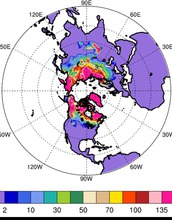
The Community Land Model version 4 (CLM4) results are used to plot the figure. It shows the amount of water derived from snow pack in Spring 2003 predicted by CLM4, using snow-pack data from 2002. Its spatial pattern is comparable to those observed by satellites.
Credit: Yong-Fei Zhang, The University of Texas at Austin
Download the high-resolution PNG version of the image. (382.3 KB)
Use your mouse to right-click (Mac users may need to Ctrl-click) the link above and choose the option that will save the file or target to your computer.
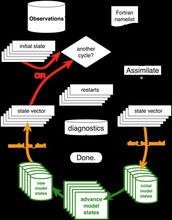
This is the DART view of ensemble data assimilation for models that run as separate executables. Starting at the top and working clockwise: Everything is driven by a Fortran namelist and the presence or absence of observations. A Fortran executable named 'filter' reads a namelist, an initial state for the ensemble, and a file containing observations and goes to work. Given the observations and an initial state, 'filter' assimilates the observations and then determines how far to advance the model (using information from the namelist and the observation file). 'filter' forks a shell script to the system and it is this shell script that is responsible for three things: 1) for converting the DART state vectors and 'advance_to_time' to the format required by the underlying model, 2) advancing the model, and 3) converting the model output into a form suitable for 'filter'. [The script is responsible for the lower portion of the diagram.] The model advances each ensemble member (either in turn or all-at-once) and the model output is converted to the input format expected by 'filter'. The shell script finishes and signals 'filter' to continue. We are now back at the beginning and the cycle continues as long as there are observations to assimilate or until the control information in the Fortran namelist is met. When that happens, a set of restart files is written (suitable to continue an experiment with more observations) and diagnostic files are written. These diagnostic files allow for the exploration of the assimilation before and after each assimilation step and for exploration of the assimilation in 'observation space'; each real observation is paired with the estimates of the observation from all of the ensemble members (if desired). Minimally, the ensemble mean estimate of the observation and the ensemble spread of the estimates is recorded.
Credit: NCAR
Download the high-resolution PNG version of the image. (762.5 KB)
Use your mouse to right-click (Mac users may need to Ctrl-click) the link above and choose the option that will save the file or target to your computer.
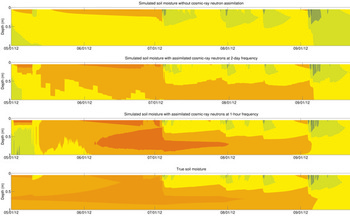
Soil moisture simulations for the Park Falls Ameriflux site. The results show the benefits of assimilating aboveground cosmic-ray neutrons to better constrain soil moisture profile in hydrometeorological models. Assimilating aboveground cosmic-ray neutrons show remarkable improvement in simulated soil moisture (second and third panels) compared to the case where these measurements are not assimilated (top panel). Furthermore, the high-frequency measurement commonly used in cosmic-ray neutron sensors (i.e., 1-hour frequency; third panel) suggests better agreement with true soil moisture profile compared to a lower-frequency case (i.e., every 2 days) which is common for satellite remote sensing products.
Credit: Rafael Rosolem (University of Bristol)
Download the high-resolution JPG version of the image. (3.4 MB)
Use your mouse to right-click (Mac users may need to Ctrl-click) the link above and choose the option that will save the file or target to your computer.
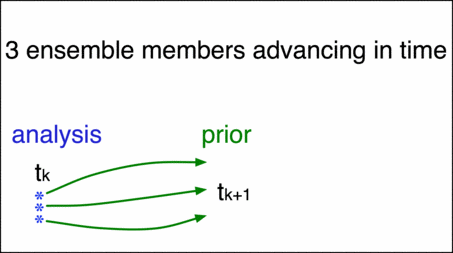
DART is a community facility for ensemble data assimilation developed and maintained by the Data Assimilation Research Section (DAReS) at the National Center for Atmospheric Research (NCAR). DART provides modelers, observational scientists, and geophysicists with powerful, flexible data assimilation tools that are easy to implement and use and can be customized to support efficient operational DA applications.
Credit: Jeffrey Anderson
Download the high-resolution GIF version of the image. (70.8 KB)
Use your mouse to right-click (Mac users may need to Ctrl-click) the link above and choose the option that will save the file or target to your computer.
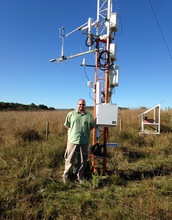
Cosmic-ray soil moisture sensor installed at the Federal University of Santa Maria SulFlux site in Brazil.
Credit: Rafael Rosolem
Download the high-resolution JPEG version of the image. (484.7 KB)
Use your mouse to right-click (Mac users may need to Ctrl-click) the link above and choose the option that will save the file or target to your computer.


